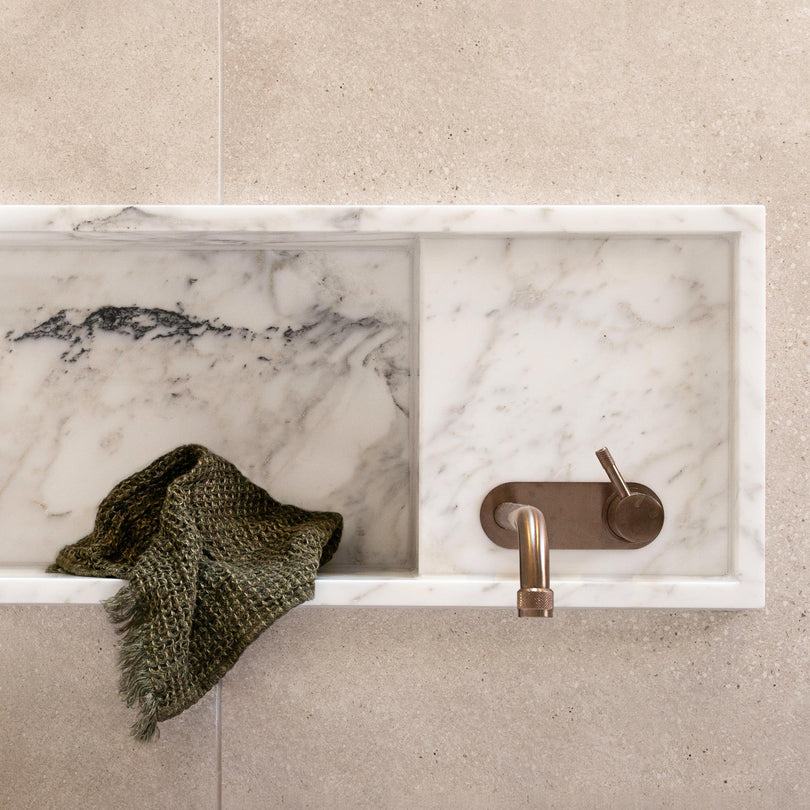Getting a good night's sleep can be impacted considerably by our sleep hygiene, which includes habits, behaviours and environmental factors that promote consistent and high-quality sleep. By considering all five senses when it comes to your evening routine, from the colour and texture of your bedding to the sounds and scents you surround yourself with, you can create a sanctuary that invites calm and relaxation and helps you to get the best sleep possible.
 Basix Linen Quilt in Ayrton, Flocca Linen Pillowcase in Ayron
Basix Linen Quilt in Ayrton, Flocca Linen Pillowcase in Ayron
Smell
Aromatherapy can be traced back to ancient Egyptian, Chinese and Roman societies using essential oils for health and healing, with studies showing that the practice can significantly improve sleep quality as well as lower stress, anxiety, fatigue and depression. Some sleep-inducing scents include lavender, clary sage, rose and chamomile, while others such as citrus, peppermint and bergamot are known for their energising qualities and are best left for the daytime. For a dreamy evening ritual, take your pick of an oil burner, diffuser, candle, room spray or topical application to scent your bedroom naturally.

Sound
Many of us are sensitive to sound when we are trying to drift off to sleep, and while a soundproof bedroom would be ideal, nighttime noise is a reality for most people. Thankfully there are simple ways to drown out external sound, not to mention distract from constant thoughts. From white noise and nature sounds (think: the pitter-patter of raindrops or a flowing stream) to sleep stories and guided meditation, you’ll discover plenty of options on apps such as Calm and Spotify designed specifically to help you sleep. Making a relaxing music playlist might also do the trick, and if you prefer silence, a quality pair of earplugs or noise-cancelling headphones may be the best option for you.
We enjoy 'Deep Sleep' by Spotify. click here to listen.

Taste
It's no surprise that food and drink play a role in influencing our quality of sleep, and following tried-and-tested methods such as limiting caffeine after midday and allowing three hours between your last meal and bedtime (to aid digestion and reduce the likelihood of heartburn and insomnia) will set you up for optimal rest. For a soothing bedtime ritual, sip a warm cup of chamomile tea, a natural stress reliever with a mild sedative effect, an hour before climbing between the sheets. Lavender, passionflower and valerian are other relaxing herbal options for a cosy, sleep-inducing nightcap.
 Flocca Linen Flat Sheet in Fog
Flocca Linen Flat Sheet in Fog
Touch
Our sense of touch includes our surrounding temperature and the textures we feel, both of which contribute to our well-being and in turn our sleep quality. To ensure the best shut-eye possible, creating a cool, comfortable and texturally appealing sleep environment is key, with natural, breathable bedding such as pure linen proving ideal for creating a luxurious and restful sleep space. With a rich tactile appeal that soothes the senses, our pure linen bedding can be effortlessly layered up or down to achieve the perfect temperature in all seasons.
 Basix Linen Stripe Cushion in Mare/Bere, Flocca Linen Flat Sheet in Fog, Flocca Linen Pillowcases in Kali, Sable, Roy and Fog
Basix Linen Stripe Cushion in Mare/Bere, Flocca Linen Flat Sheet in Fog, Flocca Linen Pillowcases in Kali, Sable, Roy and Fog

Sight
Research shows that certain colours may promote comfort and relaxation, so it makes sense to use these hues in your bedroom. For a restful slumber, look to nature-inspired colours such as cool, calming blues or a tranquil green palette reminiscent of a bucolic landscape. Serene shades of white and cream can also lend a peaceful feeling to your bedscape. In addition to choosing the best colours for sleep, limiting blue light, which boosts cortisol and suppresses melatonin levels, is also recommended. As this is most commonly emitted from computer screens and mobile devices, consider replacing technology with a book or practising meditation to help wind down for deep and restorative sleep.









